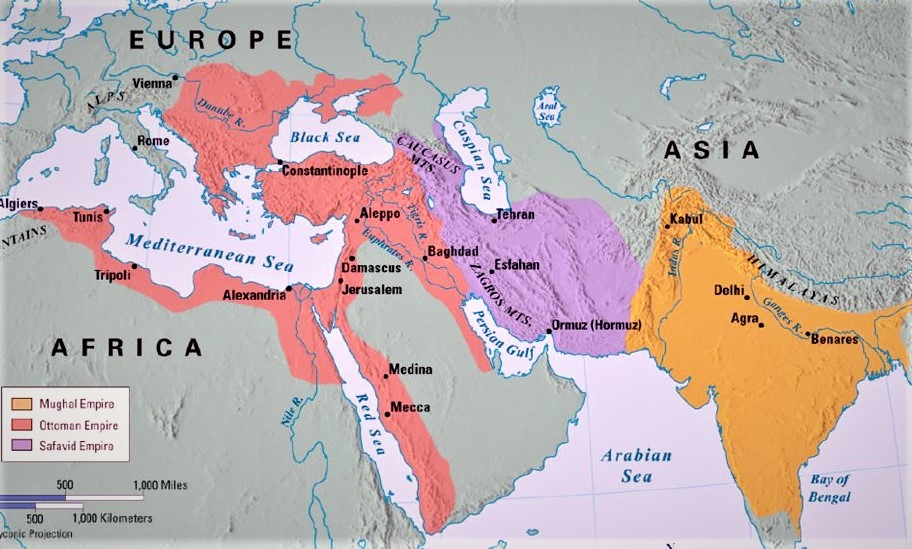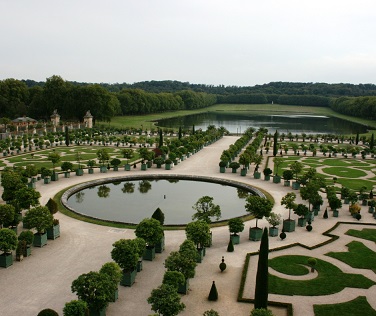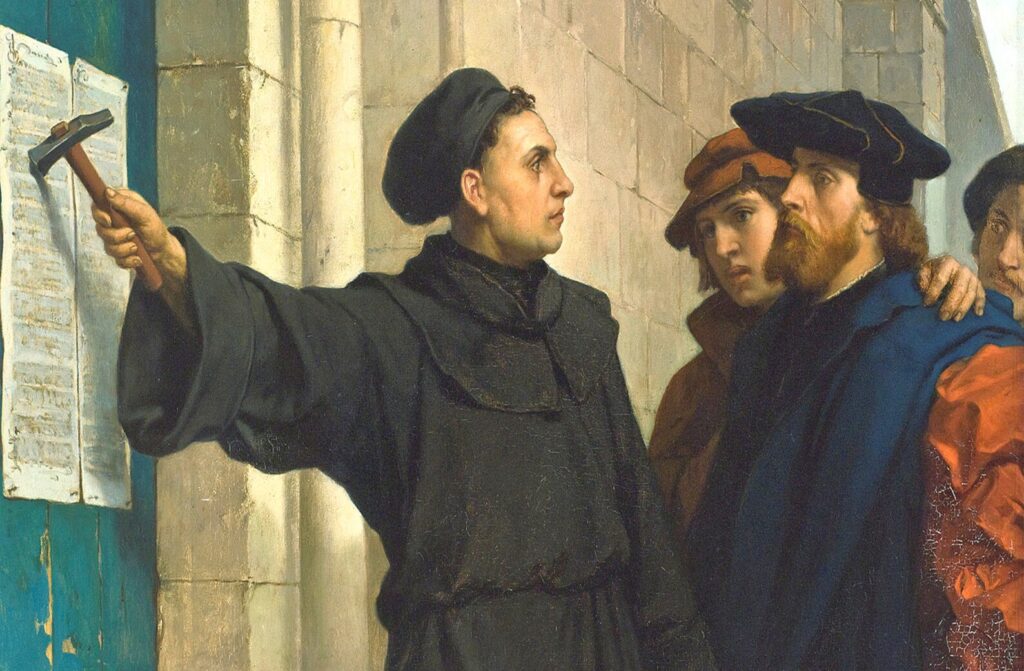by Emily Glankler
Two units in and we’re finally moving forward in time! But, besides the new era, Unit 3 is still a non-chronological approach to history that looks more like Units 1 and 2 than its counterpart, Unit 4. It is almost just an addendum to Unit 1: “Here are the various states that existed around the world from 1200-1450 and now [in Unit 3] here are new, stronger land-based empires but notice they’re doing mostly the same things!”
Why is Unit 3 called “Land-Based Empires?”

The overarching theme of 1450-1750 is the rise of massive maritime empires and their impact on new and traditional networks of exchange. With this in mind, the entire point of Unit 3 is just to establish what aspects of traditional state building are being continued from the previous era. Before we blow open the status quo with the trans-Atlantic empires and increasing encroachment of Europeans in Asia, the College Board wants us to first just establish what’s going on in traditional land-based empires. Students can sometimes get the idea that as soon as 1492 hits, everything in the world changes and so Unit 3 is our antidote to that thinking. Nope, Asian empires were still insanely powerful and important (more so than any European arrival in this era.) And even though the trans-Atlantic slave trade is going to ramp up in this era, most of Africa, outside the West, is still independent, thriving, and focused on interactions with Asia. It’s also a reminder to students that Europe isn’t only exploring/conquering/colonizing. They are also developing their own state building methods and entering their Age of Absolutism which will be very important context for the Enlightenment and Revolutions of Unit 5.
Essentially, Unit 3 is seeing what is going on with states apart from the “discovery” of the New World and the rising power of Europe. We’ll have plenty of time to talk about that in Unit 4, and honestly, the rest of the course.
With this interpretation…
How should we approach the content of Unit 3?

Unit 3 is short, sweet, and entirely thematic. The unit isn’t organized chronologically, or even geographically, in any way. It should be seen as a “birds eye view” of land-based empires, mostly in Afro-Eurasia: How are they expanding? (Short answer: gunpowder.) How are they administering their much-larger territory? (This is the most important question of the unit.) And then, randomly, what’s going on with belief systems? Topic 3.3 can seem out of place. (At my APSI when I was introduced to the new curriculum, my table of teachers searched high-and-low for the Protestant Reformation and were surprised to find it casually mentioned in this small topic titled “Empires: Belief Systems.”)
The big idea of Unit 3 is just that land-based empires took the new technology (that was diffused on networks of exchange over the last era) and used it to build bigger empires than we’ve ever seen, especially the Gunpowder Empires of Asia. Because of this, they had to develop even more complex systems of administration to maintain control over the growing, and increasingly diverse, population. And one of the biggest sources of conflict and division in this era was over internal fights within religions: the Protestant Reformation and Religious Wars in Europe; the Sunni-Shia fighting between the various Islamic empires; and even the rise of new syncretic religions, like Sufism, in an attempt to appease diverse groups. The point is that the developments we learned in Units 1 and 2 are not going away: they’re just getting more complicated.
So is Unit 3 entirely thematic? Are there any “events” or traditional chronology?

There is no need for traditional chronology in Unit 3 – we’ll get to that in Unit 4. Think of this unit as the “constant” in our global experiment (of which Unit 4 and the “Age of Discovery” will be the variable.) These state building techniques and religious conflicts are ongoing throughout the era. While it might be vaguely helpful for students to know that Martin Luther began his protesting in 1517 or Suleiman the Magnificent brought the Ottomans to their height in the mid-1500s, none of these are required.
Should we just combine Unit 3 with Unit 4?

Short answer: kind of.
As we’ll see, Unit 4 is… insane. It’s so huge and complicated and detail-oriented. Because of this, I like to keep Unit 3 separated so that I don’t just add more content to an already overwhelming era. But I definitely do not treat Unit 3 as a full, independent unit that needs to be covered (and then assessed) in the same way as others. In all honesty, I spend about a week and half on the entire unit, and much of that is taken over with a “Build Your Own Land-Based Empire” project. Generally, the concepts in Unit 3 are very easy to grasp: gunpowder makes states more powerful; leaders figure out innovative ways to amass power over local elites; and religious divisions cause conflict. The most important aspect of this unit is just making sure students can point to a few specific examples of each historical development and then move on. This is a great opportunity for a project or a writing workshop. It’s also a great opportunity to review those SPICE-T themes we introduced in Unit 1 (and maybe forgot about in Unit 3?)
Whether you cover them separately or combine them together, just know that Unit 3 deserves far less of your time than Unit 4 will. Plan accordingly.
I still don’t quite understand “Land-Based Empires.” What other resources are out there to help me get through Unit 3?

You are not alone. Many experienced teachers have a hard time figuring out how to tackle this unit, so much so that I made an entire YouTube video walking teachers through my approach to Unit 3:
Here are some of my other favorite tried-and-true resources for Unit 2.
YouTube Reviews
- “AP World History Unit 3: Land-Based Empires” (Anti-Social Studies)
- “AP World History Unit 3 Playlist” (Heimler’s History)
- “AP World History Modern: Unit 3 Review” (Stephanie Gorges)
- “3.2 Deep Dive: Devshirme” (Anti-Social Studies)
- “Illustrative Examples: Maratha-Mughal Conflict” (Freeman-pedia)
- “Illustrative Examples: Ottoman Tax Farming” (Freeman-pedia)
Unit 3 Lesson Plans and Resources
- Unit 3 LEQ Workshop / “Build Your Own Early Modern State” lessons available in the AP World Teacher Starter Pack (Anti-Social Studies)
- Land-Based Empires (Freeman-pedia)

Emily Glankler has taught almost every Social Studies course for the past decade from 6th grade World Cultures through AP® U.S. History but her favorite course to teach is AP® World History. She has taught AP® History courses at both private and public high schools in Austin, Texas and she was the team lead responsible for bringing AP® World (and building the curriculum from scratch) to the last two high schools where she has taught. Emily has also led professional development within Austin ISD as an Instructional Coach as well as presenting to an audience at SXSW EDU about incorporating current events into the core curriculum. She has a B.A. in History from the University of North Carolina at Chapel Hill and an M.A. in History from Texas State University. In addition to teaching full time, Emily also writes and produces a history podcast called Anti-Social Studies that is used by teachers and students in history classrooms around the country.
 Help
Help